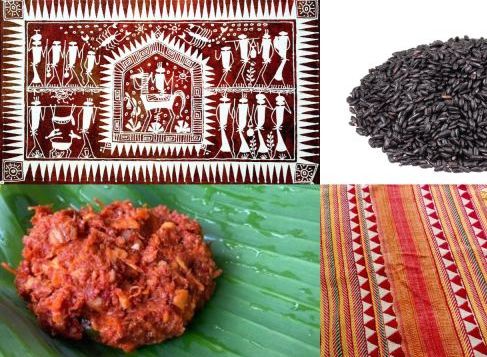Description

Disclaimer: Copyright infringement not intended.
Context
Seven products from Odisha, ranging from the Similipal Kai chutney made with red weaver ants to the embroidered Kapdaganda shawl, have bagged the coveted Geographical Indication (GI) tag in recognition of their exclusivity to the state.
Details
Introduction to GI Tags
- Geographical Indications (GI) signify a product's origin from a specific geographical region.
- In India, the Department for Promotion of Industry and Internal Trade, Ministry of Commerce and Industry, bestows GI tags. These tags assure consumers of the product's quality and uniqueness linked to its geographical locality.
Significance of GI Tags:
- Quality Assurance: GI tags convey an assurance of quality and distinctiveness attributed to the product's origin in a particular geographic area.
- Authenticity Guarantee: They validate the authenticity of traditional methods, skills, and characteristics associated with the product's origin.
- Legal Protection: GI registration is granted to a geographical area, not individual traders. Authorized traders receive a unique GI number to use the GI logo. Unauthorized usage by others can lead to legal repercussions under The Geographical Indications of Goods (Registration and Protection) Act, 1999.
Implications of GI Registration:
- Protection of Local Interests: GI tags safeguard the interests of local artisans, farmers, and producers by preventing unauthorized use or misrepresentation of their unique products.
- Market Recognition: GI-tagged products gain recognition for their quality, authenticity, and adherence to traditional methods.
- Economic Development: Encourages economic growth by promoting local products, supporting livelihoods, and boosting rural economies.
GI Tag Application Process:
- Application Submission: Producers or groups representing a product's origin area can apply for GI registration.
- Examination and Approval: Authorities assess the product's distinctiveness, traditional methods, and association with the region before granting the GI tag.
- Authorized Use: Once registered, authorized traders are permitted to market the product using the GI logo, ensuring its authenticity.

Recent GI Tags from Odisha
Kapdaganda Shawl:
- Origin: Woven and embroidered by Dongria Kondh tribe in Odisha's Rayagada and Kalahandi districts.
- Distinctive Features:
- Off-white coarse cloth with red, yellow, and green threads representing mountains, peace, and blood respectively.
- Motifs of lines and triangles symbolizing the community's connection with mountains.
- Worn by both men and women, often exchanged during courtship as a symbol of commitment.
Lanjia Saura Painting:
- Origin: Belongs to the Lanjia Saura community in Rayagada district.
- Characteristics:
- Exterior murals painted on mud walls as gratitude to deities and ancestors.
- Depictions of tribal life, nature, animals, celestial bodies in white over crimson-maroon backgrounds.
- Ritualistic association and appreciation for nature reflected in the art.
Koraput Kala Jeera Rice:
- Origin: Preserved by tribal farmers in Koraput for about 1,000 years.
- Distinctiveness:
- Black rice variety with a unique aroma, taste, and high nutritional value.
- Known as 'Prince of Rice' or 'Kala Jeera' due to its resemblance to cumin seeds.
- Consumption aids in improving haemoglobin levels and metabolism.
Similipal Kai Chutney:
- Origin: Mayurbhanj district; made from red weaver ants found in Similipal forests.
- Features:
- Traditional chutney rich in nutrients like protein, calcium, iron, etc.
- Made by grinding red ants manually; believed to boost immunity and prevent diseases.
- Represents the region's indigenous culinary tradition and reliance on forest resources.
Nayagarh Kanteimundi Brinjal:
- Origin: Cultivated widely in Nayagarh district.
- Unique Characteristics:
- Brinjal variety with prickly stems; quick cooking, distinct taste, and abundant seeds.
- Known for resistance to insects, requiring minimal pesticide usage.
- Historical significance dating back nearly a century; originates from hilly areas.
Odisha Khajuri Guda:
- Origin: Extracted from date palm trees in Gajapati district.
- Notable Attributes:
- Dark brown organic jaggery with a unique taste; natural sweetener.
- Traditional preparation in trapezoidal form known as 'Patali Gur'.
- Offers a distinctive flavour and is an essential element in local cuisines.
Dhenkanal Magji:
- Origin: Produced from buffalo milk in Dhenkanal district.
- Key Features:
- Cheese-based sweet with unique taste, appearance, and nutritional value.
- Prepared by draining moisture from cheese, frying, and shaping into balls.
- Historical significance in the region; supports the livelihood of local producers.

Conclusion
These products with GI tags signify Odisha's rich cultural heritage, traditional craftsmanship, indigenous agricultural produce, and distinctive culinary traditions. The tags ensure authenticity, protect local interests, and offer consumers certified products with unique qualities.
|
PRACTICE QUESTION
Q. Which of the following statements regarding Geographical Indication (GI) tags for products from Odisha is/are correct?
1.GI tags are awarded to products based on their origin in a specific geographical region.
2.The Kapdaganda shawl, embroidered by the Dongria Kondh tribe, and Similipal Kai chutney made with red weaver ants are among the products from Odisha that have received GI tags.
3.GI registration is granted to individual traders dealing with the products, ensuring exclusive rights to sell those items.
4.Unauthorized use of GI-tagged product names by traders can lead to legal action under The Geographical Indications of Goods (Registration and Protection) Act, 1999.
Select the correct answer using the codes below:
A. 1 and 2 only
B. 1, 2, and 4 only
C. 1, 3, and 4 only
D. 1, 2, 3, and 4
Answer: A
|















